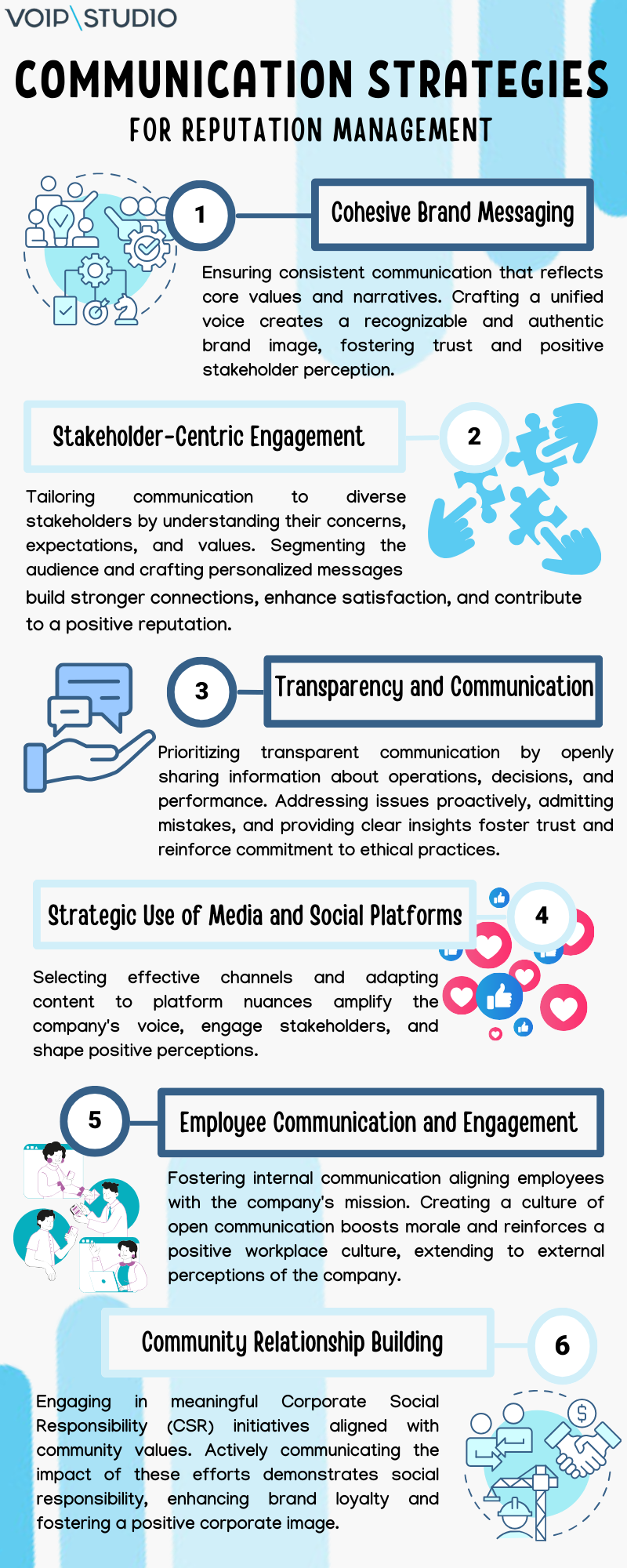
Table of contents
Like a company’s personality, corporate reputation extends beyond mere imagery. It reflects the collective judgment of stakeholders regarding a company’s character, values, and actions.
In the competitive business arena, the significance of a positive corporate reputation cannot be overstated. It is a dynamic force that can open doors, foster trust, and attract opportunities. Conversely, a tarnished reputation can lead to skepticism, loss of clientele, and diminished standing in the market.
Throughout our exploration, we’ll delve into the complexities of defining and understanding corporate reputation, acknowledging its multifaceted nature.
Components of corporate reputation
What builds a company’s public image is the perception of stakeholders -customers, employees, investors and society- about the company’s internal and external communications.
We dissect three fundamental facets shaping a positive corporate reputation:
- Trustworthiness and transparency: The foundations of trust are built with consistent displays of reliability, honesty and transparency toward all stakeholders.
- Product and service quality:The caliber of products and services reflects on customer satisfaction and is a crucial determinant of overall corporate reputation. Stakeholders, through their experiences and expectations, play a vital role in shaping this dimension.
- Corporate social responsibility (CSR):With their diverse values and expectations, stakeholders contribute to the CSR narrative. Whether it’s environmentally conscious consumers or socially responsible investors, their appreciation enhances the corporate reputation of an organization.
Benefits of a good corporate reputation
A strong corporate reputation is not merely a badge of honor; it is a strategic asset that yields a spectrum of tangible benefits for an organization. Cultivating and maintaining a positive corporate image can bring a multitude of advantages:
- Market competitiveness: A good reputation acts as a formidable competitive edge. It draws the attention of customers and clients, influencing their choices amid a sea of options. A positive image positions a company favorably, setting it apart from competitors and establishing a strong market presence.
- Customer trust and loyalty: Trust is the currency of successful business relationships. A positive corporate reputation engenders trust among customers. When clients believe in a company’s integrity, reliability, and commitment to quality, they are likelier to remain loyal and advocate for the brand.
- Attracting and retaining talent: The best and brightest talent seeks out employers with positive reputations. A company known for ethical practices, a positive work culture, and a commitment to corporate responsibility becomes a magnet for skilled professionals. Additionally, existing employees are likelier to stay loyal to an organization with a favorable reputation.
- Resilience in crisis: A good reputation serves as a shield in times of crisis. A company with a positive image has already established a reservoir of goodwill with stakeholders. This reservoir becomes critical during challenging periods, helping the organization weather crises with greater public understanding and support.
These benefits illuminate the transformative impact that a positive image can have on an organization’s overall success and sustainability.
Communication strategies for reputation management
Strategic communication is not a mere transmission of messages; it is designed to achieve specific objectives. It requires a selection of messages, channels, and timing to convey information effectively.
When creating and maintaining an excellent corporate reputation, strategic communication becomes the linchpin guiding how a company is perceived by its public.
Crisis and reputation management
Crisis and reputation management constitute more than reactive measures; they embody proactive frameworks designed to anticipate, respond to, and recover from unforeseen challenges with transparency and effectiveness.
Proactive crisis communication planning
At the core of crisis management lies proactive communication planning. This entails the identification of potential crises, the establishment of communication protocols, and the designation of spokespersons. Such foresight empowers companies to respond swiftly, maintaining control over the narrative and safeguarding stakeholder trust.
Transparent and timely communication
Central to crisis management is transparent and timely communication. Openly acknowledging challenges, providing accurate information, and outlining action plans demonstrate a commitment to honesty and accountability. Timely communication, especially in the age of instant information dissemination, is critical to managing perceptions and mitigating reputational damage.
Stakeholder engagement in crisis
Engaging with stakeholders during a crisis entails actively listening to concerns and feedback. This two-way communication fosters a sense of shared responsibility and community, even in challenging times. Acknowledging stakeholder concerns and addressing them transparently can contribute to rebuilding trust.
Adaptability and learning
An effective crisis management strategy acknowledges the dynamic nature of crises and adapts accordingly. Learning from each crisis, whether significant or minor, enables companies to refine their crisis management approaches continually. This adaptability ensures the organization is better prepared for future challenges and enhances its resilience.
Employee relations and corporate reputation
Employee relations and corporate reputation are intertwined elements that significantly impact how a company is perceived internally and externally.
Fostering a positive corporate culture begins with robust internal communication. Keeping employees informed about company developments, goals, and values creates a sense of inclusion and shared purpose. Transparent communication builds trust and loyalty, reinforcing the alignment of employee values with the company’s mission.
Acknowledging and celebrating employee contributions are vital to building a positive corporate reputation. Recognition programs, awards, and public acknowledgments demonstrate that the company values the efforts of its workforce. This boosts morale and contributes to a positive external image as employees become ambassadors for the company’s values.
Aligning employee actions with corporate values is pivotal in shaping external perceptions. When employees embody the company’s values in their interactions, both within and outside the organization, it contributes to a consistent and positive corporate image. This alignment reinforces the company’s commitment to its stated values and principles.
Establishing open dialogue and conflict resolution channels is crucial in mitigating potential issues that could impact the company’s reputation. Employees should feel comfortable expressing concerns, and mechanisms should be in place for addressing conflicts promptly and fairly. A positive internal environment reflects positively on the company’s external reputation.
Employee satisfaction is an internal metric and a key influencer of external perception. Satisfied employees are more likely to become advocates for the company, speaking positively about their experiences. This advocacy extends to online platforms, social networks, and professional circles, contributing to a favorable external reputation.
Reputation measurement and control
Reputation control is an adaptive and continuous improvement process. Regular reassessment of strategies, learning from feedback, and staying attuned to changing stakeholder expectations enable companies to shape their reputation narrative proactively.
The digital age emphasizes the significance of online reputation monitoring. Keeping a vigilant eye on online platforms, social media channels, and review sites allows organizations to track real-time mentions, reviews, and sentiments. This awareness empowers companies to promptly address issues, correct misinformation, and amplify positive narratives, fortifying their virtual reputation.
Establishing and tracking Key Performance Indicators (KPIs) specific to reputation provides a quantitative measure of success. These KPIs, including customer satisfaction scores, employee engagement metrics, and sentiment analysis from social media, offer tangible ways to gauge the effectiveness of reputation management strategies over time.
Media analysis and press monitoring contribute to a comprehensive understanding of how the company is portrayed in the public sphere. Tracking news articles, press releases, and editorial content enables organizations to manage media relations proactively, ensuring accurate representation and timely interventions in case of negative coverage.
Conducting crisis simulation exercises is a proactive strategy for evaluating preparedness for potential reputational challenges. Simulating crisis scenarios allows companies to identify vulnerabilities, test response strategies, and refine crisis communication plans. This approach enhances control over the narrative during challenging times, contributing to effective reputation management.
Active engagement with stakeholders and building positive relationships are integral to reputation control. Establishing open lines of communication, addressing concerns proactively, and showcasing corporate responsibility all play a role in shaping perceptions. Positive stakeholder relationships are a buffer during reputational challenges, contributing to overall reputation resilience.
How can VoIP help you build a good corporate reputation?
The strategic implementation of VoIP technology goes beyond efficient communication—it becomes a tool for shaping and enhancing corporate reputation. From cost-effectiveness to innovation and reliability, VoIP can contribute to a favorable external perception, showcasing a company that embraces modern communication solutions to foster efficiency and connectivity.
Enhanced communication efficiency
VoIP technology facilitates seamless and efficient communication within and beyond the organization. The ability to make voice calls, conduct video conferences, and share real-time information enhances employee collaboration. This efficiency in communication reflects positively on the company’s operations and responsiveness, contributing to a favorable reputation.
Example: Using VoIP technology, development teams can conduct follow-up meetings via videoconferencing, facilitating the review of project progress in a more visual and efficient way. This improves collaboration among employees, reduces waiting times and optimizes decision making.
Cost-effectiveness and sustainability
Utilizing VoIP often translates to cost savings compared to traditional telephony systems. The streamlined infrastructure, lower maintenance costs, and reduced expenses for long-distance communication contribute to a perception of financial prudence and sustainability. This cost-effectiveness can be communicated externally, reinforcing the company’s commitment to efficient resource utilization.
Example: By migrating to VoIP, the company reduces the costs associated with international calls by using more competitive rates. These savings are reflected in financial reports, demonstrating efficient resource management and a sustainable financial strategy, generating confidence among shareholders.
Accessibility and flexibility
VoIP technology improves accessibility and flexibility by enabling communications from anywhere with an Internet connection. This flexibility makes it easier for employees to stay connected and collaborate efficiently, which, in turn, reinforces brand reputation by demonstrating a company that is agile, modern and committed to employee and customer satisfaction through convenient and diverse access to communications.
Example: The implementation of VoIP allows customers to contact customer service through an online chat integrated into the company’s website. This offers customers a fast and convenient communication option, enhancing their experience and generating a positive perception of the company.
Scalability and innovation
As companies grow, VoIP systems offer scalability without requiring extensive infrastructure changes. This scalability aligns with a company’s growth trajectory, portraying it as forward-thinking and adaptable. VoIP systems often come with innovative features, demonstrating a commitment to leveraging technology for enhanced communication.
Example: With VoIP systems, the company can easily add additional lines to support staff growth or geographic expansion.
Advanced features for customer interaction
VoIP systems offer advanced features like call recording, analytics, and interactive voice response (IVR). These features can enhance customer interactions, providing a more personalized and efficient experience. Positive customer experiences contribute significantly to a company’s reputation, and VoIP technology plays a role in delivering enhanced customer communication.
Example: In a client’s telephone inquiry with the customer service team, the implementation of an automated interactive voice response (IVR) system transfers the call to the appropriate person or department based on their needs. This streamlines the customer service process, improves efficiency and provides a more personalized experience, generating a positive perception of the company.
If you’re interested in trying a VoIP service that offers all the advanced features in the market, sign up for a 30-day free trial today!
More from the blog
Want to improve your business communication?
Unlock enterprise-class call center power at affordable prices – no hardware, no delays, no surprises!







